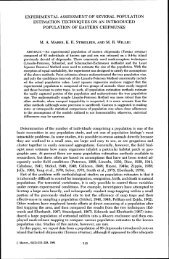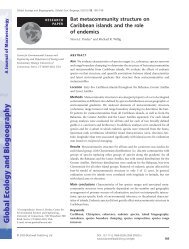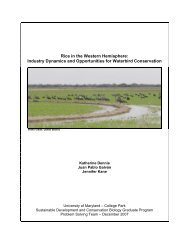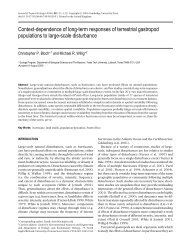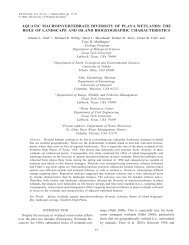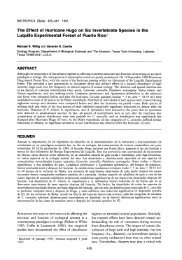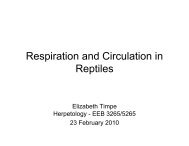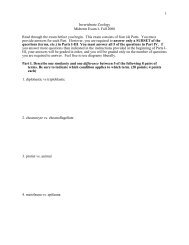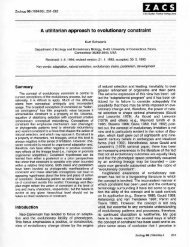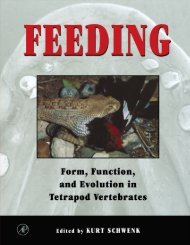Tadpole shrimp structure macroinvertebrate communities in playa ...
Tadpole shrimp structure macroinvertebrate communities in playa ...
Tadpole shrimp structure macroinvertebrate communities in playa ...
Create successful ePaper yourself
Turn your PDF publications into a flip-book with our unique Google optimized e-Paper software.
146<br />
removed. Hence, one might expect their abundances<br />
to be positively correlated with tadpole<br />
<strong>shrimp</strong> density across control microcosms. However<br />
with<strong>in</strong> control trials, mo<strong>in</strong>id density was<br />
negatively correlated with tadpole <strong>shrimp</strong> density<br />
(Fig. 2). Diaptomid abundance <strong>in</strong> microcosms was<br />
marg<strong>in</strong>ally correlated with tadpole <strong>shrimp</strong> density<br />
<strong>in</strong> one control trial (r ¼ )0.296, p ¼ 0.060). The<br />
presence of tadpole <strong>shrimp</strong> may be beneficial to<br />
these taxa, but such benefits decrease with<br />
<strong>in</strong>creas<strong>in</strong>g tadpole <strong>shrimp</strong> density.<br />
Discussion<br />
The <strong>macro<strong>in</strong>vertebrate</strong> composition of <strong>playa</strong><br />
microcosms was highly variable with<strong>in</strong> treatment<br />
groups, probably as a result of subtle differences <strong>in</strong><br />
hatch<strong>in</strong>g cues among replicates, lack of perfect<br />
homogeneity <strong>in</strong> soil samples, natural variation<br />
<strong>in</strong> hatch<strong>in</strong>g rates for organisms, <strong>playa</strong>-specific<br />
differences <strong>in</strong> the taxonomic composition of<br />
<strong>in</strong>nocula, and our ability to remove tadpole <strong>shrimp</strong><br />
from treatment microcosms. Even with<strong>in</strong> the statistical<br />
constra<strong>in</strong>ts imposed by such variability, it<br />
was clear that tadpole <strong>shrimp</strong> played an important<br />
role <strong>in</strong> structur<strong>in</strong>g these <strong>communities</strong>.<br />
The presence of tadpole <strong>shrimp</strong> was associated<br />
with reduced abundances of ostracods, Culicidae,<br />
and Psychodidae. Mo<strong>in</strong>idae, Diaptomidae, Streptocephalidae,<br />
and Sm<strong>in</strong>thuridae were positively<br />
affected by the presence of tadpole <strong>shrimp</strong>, and<br />
microcosms with tadpole <strong>shrimp</strong> had higher taxonomic<br />
richness and diversity. The importance of<br />
tadpole <strong>shrimp</strong> on <strong>playa</strong> microcosm <strong>communities</strong><br />
is a consequence of their dual role as predators<br />
and ecosystem eng<strong>in</strong>eers, perhaps analogous to<br />
the effects that rodents have on desert plant<br />
<strong>communities</strong> through seed predation and burrow<strong>in</strong>g<br />
activities (Moorhead et al., 1988; Brown &<br />
Heske, 1990; Willig & McG<strong>in</strong>ley, 1999).<br />
<strong>Tadpole</strong> <strong>shrimp</strong> are opportunistic predators<br />
that have been shown to decrease abundances of<br />
prey species (Dodson, 1987; Fry et al., 1994;<br />
Walton, 2001). As tadpole <strong>shrimp</strong> <strong>in</strong>crease <strong>in</strong><br />
abundance, the total number of prey consumed<br />
<strong>in</strong>creases, lead<strong>in</strong>g to negative correlations between<br />
many taxon abundances and tadpole <strong>shrimp</strong> <strong>in</strong><br />
control trials. Predation may be accelerated<br />
as tadpole <strong>shrimp</strong> broaden their diet as detritus<br />
becomes scarce. In addition, tadpole <strong>shrimp</strong> may<br />
have <strong>in</strong>direct positive effects on community<br />
diversity by preferentially prey<strong>in</strong>g on certa<strong>in</strong> taxa,<br />
giv<strong>in</strong>g rarer competitors a better chance of survival<br />
(i.e., predator-mediated coexistence) and lead<strong>in</strong>g<br />
to <strong>in</strong>creased taxonomic richness. Indeed, early<br />
stages of <strong>in</strong>vertebrate community development <strong>in</strong><br />
<strong>playa</strong>s are dom<strong>in</strong>ated by detritivores (Moorhead<br />
et al., 1998), that may compete for resources.<br />
In addition to predation, tadpole <strong>shrimp</strong> have<br />
forag<strong>in</strong>g behaviors that may affect community<br />
<strong>structure</strong>. <strong>Tadpole</strong> <strong>shrimp</strong> feed by sift<strong>in</strong>g through<br />
benthic debris and sediments. This may lead to<br />
direct competition with taxa, such as ostracods,<br />
which also tend to feed along the sediment surface<br />
(Delorme, 1991). Such competition could be<br />
responsible for negative correlations between<br />
many taxa and tadpole <strong>shrimp</strong> abundances <strong>in</strong><br />
control trials. The forag<strong>in</strong>g activities of tadpole<br />
<strong>shrimp</strong> may also be responsible for <strong>in</strong>creased<br />
abundances of many taxa, <strong>in</strong>creased richness, and<br />
<strong>in</strong>creased diversity <strong>in</strong> the presence of tadpole<br />
<strong>shrimp</strong>. <strong>Tadpole</strong> <strong>shrimp</strong> scatter detritus as they<br />
feed, which floats to the water surface potentially<br />
benefit<strong>in</strong>g detritivorous <strong>in</strong>vertebrates, such as collembola,<br />
which feed along the surface film, and<br />
fairy <strong>shrimp</strong>, which filter the water column<br />
(Christiansen & Snider, 1984; Hilsenhoff, 1991).<br />
Moreover, the agitation of benthic sediments may<br />
<strong>in</strong>crease the hatch<strong>in</strong>g rate of other <strong>in</strong>vertebrates,<br />
such as cladocerans and clam <strong>shrimp</strong>, which rely<br />
on changes <strong>in</strong> light or oxygen concentration as<br />
hatch<strong>in</strong>g cues (Belk & Cole, 1975; Wigg<strong>in</strong>s et al.,<br />
1980).<br />
Microcosm <strong>communities</strong> undoubtedly differ<br />
from natural <strong>playa</strong> lakes (Anderson & Smith,<br />
2004). Effects of tadpole <strong>shrimp</strong> on resident<br />
<strong>macro<strong>in</strong>vertebrate</strong> <strong>communities</strong> <strong>in</strong> microcosms<br />
may be representative of their effect dur<strong>in</strong>g early<br />
succession. Overw<strong>in</strong>ter<strong>in</strong>g residents such as<br />
phyllopod crustaceans generally dom<strong>in</strong>ate early<br />
successional stages of <strong>playa</strong> <strong>in</strong>vertebrate <strong>communities</strong><br />
(Sublette & Sublette, 1967; Moore, 1970;<br />
Lake et al., 1989). Consequently, tadpole <strong>shrimp</strong><br />
may exert strong <strong>in</strong>fluences on <strong>in</strong>vertebrate <strong>communities</strong><br />
dur<strong>in</strong>g the first few weeks of <strong>playa</strong><br />
<strong>in</strong>undation when relative abundances of <strong>in</strong>sect<br />
predators and other immigrants are low (Lake<br />
et al., 1989; Schneider & Frost, 1996; Moorhead<br />
et al., 1998). The composition of early resident



